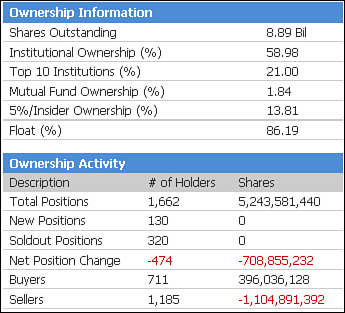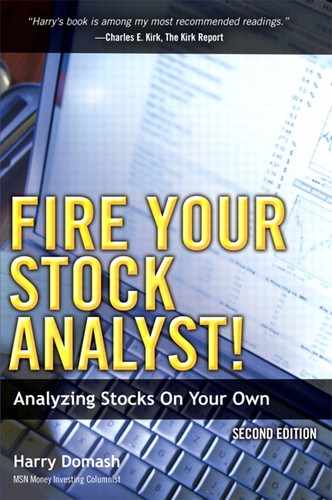13. Analysis Tool #10: Ownership Considerations
Examining the percentage of outstanding shares held by institutions and insiders can help you avoid risky stocks.
Institutional Ownership
Institutions are mutual funds, pension plans, trust funds, and other large investors, and they account for roughly 50 percent of all stockholdings. The presence of strong institutional sponsorship (large holdings) verifies that a stock is a viable growth candidate.
Institutional Percentage of Shares Outstanding
Institutional ownership is the percentage of outstanding shares held by institutions. Hedge funds are not required to report their holdings to the SEC and thus are not counted as institutional owners.
Institutions trade stocks frequently and in large quantities. By virtue of the large commissions that those trades generate, institutional money managers are more wired into the market than you and I can ever hope to be. Consequently, there is no way that you would discover a stock that institutional buyers haven’t already examined.
High institutional sponsorship (ownership) means that these tuned-in investors have analyzed the company and liked what they saw. Conversely, low institutional ownership means that institutions have analyzed the company and passed on it.
Institutions must report their holdings to the SEC (Form 13F) no later than 45 days after the end of the March, June, September, and December quarters. Thus, an institution that bought a stock on April 1 could wait until as late as mid-July to notify the SEC. While the timeliness issue diminishes the value of institutional holdings data (shown in Figure 13-1), it is still worthwhile to evaluate the information, especially for growth investors.
Figure 13-1 A portion of MSN Money’s Ownership report for Microsoft. The report also lists the top holders.

Institutions, particularly mutual funds, are most often growth investors. For “in-favor” growth stocks, institutions typically hold at least 40 percent of the outstanding shares, and usually more. In many instances, institutional ownership runs as high as 95 percent of the outstanding shares. Growth investors should view candidates with less than 40 percent institutional ownership with caution. It could very well be that institutional buyers are shunning the stock for good reason.
It’s a different story for value candidates. Mutual funds and other institutional holders often dump a stock when it tanks because they don’t want their quarterly reports to show big losers in their portfolios.
Thus, low institutional holdings should signal an out-of-favor value candidate. However, because of the reporting time lag, it could take four or five months for institutional selling to be reflected in the holdings data. Value investors should keep in mind that time lag when evaluating candidates that crashed only recently.
Judging a Stock by the Company It Keeps
Checking the names of the funds that hold large positions of a stock offers additional insight. Figure 13-2 shows Morningstar’s Top Fund Owners report, listing the mutual funds that have the largest holdings of Microsoft. Many websites report similar information, but I prefer this one because it shows Morningstar’s Star Rating of each fund. (Morningstar rates funds from one to five stars, where five is best.) That’s good information, because I’d rather buy stocks held mostly by five-star funds than those owned mainly by two-star funds.
Figure 13-2 Morningstar’s Top Fund Owners report shows the funds with the largest holdings in a company—in this case, Microsoft.

The investing style of the funds with large holdings is also significant. Stocks mostly held by momentum-style funds are riskier than those held mostly by buy-and-hold-style managers, because the momentum managers would dump their holdings at the first sign of trouble. You can tell which is which by looking up the fund’s portfolio turnover on Morningstar’s Portfolio report for the fund. Turnover measures the percentage of the fund’s trading activity. A 100 percent turnover means that, on average, the fund replaces its entire portfolio every year. Buy-and-hold-style funds have turnovers below 40 percent, and momentum funds’ turnovers typically run above 150 percent.
Insider Ownership
Insiders are key officers, members of the board, and others holding at least 10 percent of the outstanding shares.
Insider ownership is usually expressed as the percentage of the firm’s outstanding shares held by insiders. Institutions holding 10 percent of a company’s shares are considered insiders, so the total of insider plus institutional holdings can exceed 100 percent of outstanding shares.
The term “insider” has two meanings. The preceding paragraph defines insiders for the purpose of measuring “insider ownership.” However, when referring to “insider trading,” “insider” means anyone with access to nonpublic information relevant to a stock’s outlook.
Float
Insider holdings (insider ownership definition) are not available for daily trading, because insiders are restricted as to when and how often they can trade their shares. Float is defined as the number of shares that are available for daily trading. In other words, the float is the number of shares not held by insiders.
Yahoo!’s Share Statistics report shows the total number of shares outstanding, the float, and the percentage of shares held by insiders and institutions for any stock.
Avoid Very High Ownership
In days past, market gurus advised avoiding stocks with low insider ownership. They reasoned that company executives holding big stakes had a stronger interest in seeing the share price increase than those that didn’t have much “skin in the game.”
Nowadays, however, almost all corporations couple their executives’ compensation to share price performance one way or another, often via stock options. The realities of modern-day corporate life make insider ownership irrelevant in terms of executives’ motivation to keep up the share price. Nevertheless, you should still check insider ownership. Here’s why.
During the 2004–2007 timeframe, private equity firms were buying up publicly traded corporations, taking them private, loading them with debt, and then taking them public again. When they took them public again, the original private equity investors held onto big chunks of stock. But they are not long-term holders. Instead, they are waiting for an opportunity to sell their shares.
High insider ownership—say, 55 percent or more—signals risk that the insiders may be large investors who intend to dump their holdings. It’s no fun owning a stock when every few weeks large shareholders dump a few million shares onto the market.
In other instances, high insider ownership may reflect holdings owned by the founding family or by descendants of the founder. These family owners may or may not see an advantage to higher share prices.
Bottom line: Avoid companies with 55 percent or more insider ownership without further researching these issues.
Insider Trading
Insider buying or selling can be a tip-off to which way key executives see their company’s share price headed. But interpreting the information requires some care. Insiders often exercise stock options and then sell those shares on the same day. They do that because they need the cash, not necessarily because they think the share price is headed down.
If you track insider trading, focus on transactions by the chief executive officer and chief financial officer. They are the most informed about the firm’s outlook. The only significant transactions are large open-market purchases or sales that are unrelated to option exercises.
The significance of a trade depends on the trade size compared to the insiders’ total holdings, including unexercised stock options. Reuters Officers and Directors report lists unexercised stocks options for major officers.
It’s insignificant if an insider sells 20,000 shares but still holds 2 million shares. It is significant, however, if the insider sells 1.5 million of his or her 2 million shares.
Often, an insider trade may not be as significant as it appears. In the past, some companies have loaned money to executives to finance purchasing the company’s shares. In these instances, their buying reflects the deal they’re getting, rather than their view of the stock’s appreciation prospects. Also, key insiders, especially the CEO, often have rights to shares that do not appear on their listed holdings, including the Reuters options report. It may appear that they are selling all their holdings, but they actually control, or have rights to, millions of additional shares.
Insiders are supposed to report their trades by the 10th of the following month. So trades made on September 20, for instance, should be reported by October 10. However, trades made on October 9 need not be reported until November 10. Late reporting is common, and I’m unaware of an insider’s ever going to jail for late reporting of his or her trades.
The financial news media, as well as investors, both professional and amateur, monitor the SEC insider trading reports. Knowing that, you can be sure that corporate attorneys have developed creative methods that allow company execs to sell shares without the transactions appearing on SEC reports.
Summary
Despite the timeliness issue, growth investors should be cautious about investing in stocks with less than 40 percent institutional ownership, because it’s likely that the smart money is avoiding the stock. Use caution for stocks with very high insider ownership, because that signals that big shareholders may be waiting for the opportune time to reduce their holdings.
The close attention given to insider trading reports in recent years has made that data less significant as insiders learned how to game the insider trading reports.
